Zone
Crash of a Cessna 208 Caravan I in Hillsborough
Date & Time:
Aug 13, 1999 at 1311 LT
Registration:
N193GE
Survivors:
Yes
Schedule:
Manchester - Denver
MSN:
208-0193
YOM:
1991
Crew on board:
1
Crew fatalities:
Pax on board:
0
Pax fatalities:
Other fatalities:
Total fatalities:
0
Captain / Total hours on type:
3000.00
Aircraft flight hours:
6132
Circumstances:
With an auxiliary fuel tank system installed, the pilot filled the tanks and departed. A few minutes later, he noticed fuel on the floor of the cabin, and tried to reach an airport. However, the fuel fumes were so strong he elected to land in an open field. After touchdown, the airplane passed through a ditch the pilot had not observed from the air. The nose landing gear collapsed and the airplane nosed over. An airborne witness reported the pilot exited the airplane after about 5 minutes, and about 5 minutes later, the airplane caught fire and burned. The post crash fire consumed the cabin. In an interview, the pilot reported that he had not initiated use of the auxiliary fuel tank system when the accident occurred. He also reported he could not see where the fuel was coming from. The investigation revealed the tank installation did not match the FAA Form 337, the instructions for use of the ferry tank system were inadequate, and the pilot had reported that the auxiliary fuel pumps were secured to a board which was not secured to the airplane.
Probable cause:
An inadequate auxiliary fuel tank installation which resulted in a leak of undetermined origin.
Final Report:
Crash of a Mitsubishi MU-2B-26 Marquise in Southbridge
Date & Time:
Jul 11, 1985 at 1700 LT
Registration:
N727MA
Survivors:
Yes
Schedule:
Manchester - Southbridge
MSN:
342
YOM:
1976
Crew on board:
2
Crew fatalities:
Pax on board:
1
Pax fatalities:
Other fatalities:
Total fatalities:
0
Captain / Total hours on type:
1006.00
Aircraft flight hours:
26958
Circumstances:
During landing the aircraft impacted hard and skidded down the runway before it went off the left side of the runway. The left main wheel separated and the nose gear collapsed. Both pilots stated the landing approach was normal until the aircraft was approximately 15 feet above the runway at which time the aircraft abruptly descended and impacted hard with the runway. Prior to the impact, the aircraft was configured with 20° of flaps and landing gear was down and locked. The airspeed was 105 knots. Examination of the aircraft disclosed that the aft main gear doors were open and the nose down lock limit switch was defective. The switch is required to close the aft main gear door. The flight test by the mfg determined that opened aft main gear door has none to unnoticeable effect on stall speed. Aircraft speed at touchdown based on computations from prop slash marks was 86 knots. The stall speed of aircraft at prevailing weight and flaps configuration is below this speed, the aircraft weight was approximately 9,000 lbs.
Probable cause:
Occurrence #1: loss of control - in flight
Phase of operation: landing
Findings
1. (c) reason for occurrence undetermined
2. (c) proper descent rate - exceeded
----------
Occurrence #2: hard landing
Phase of operation: landing - flare/touchdown
Findings
3. (c) level off - not possible - pilot in command
----------
Occurrence #3: gear collapsed
Phase of operation: landing - flare/touchdown
Findings
4. Landing gear, main gear - overload
5. Landing gear, nose gear - overload
Phase of operation: landing
Findings
1. (c) reason for occurrence undetermined
2. (c) proper descent rate - exceeded
----------
Occurrence #2: hard landing
Phase of operation: landing - flare/touchdown
Findings
3. (c) level off - not possible - pilot in command
----------
Occurrence #3: gear collapsed
Phase of operation: landing - flare/touchdown
Findings
4. Landing gear, main gear - overload
5. Landing gear, nose gear - overload
Crash of a Piper PA-61P Aerostar (Ted Smith 601) in Oxford: 2 killed
Date & Time:
Jun 22, 1981 at 2115 LT
Registration:
N86BW
Survivors:
No
Schedule:
Oxford - Manchester
MSN:
61-0468-185
YOM:
1978
Crew on board:
1
Crew fatalities:
Pax on board:
1
Pax fatalities:
Other fatalities:
Total fatalities:
2
Captain / Total hours on type:
200.00
Circumstances:
Shortly after takeoff from Oxford Airport, one of the engine failed. The pilot initiated a right turn when the airplane entered an uncontrolled descent and crashed, bursting into flames. Both occupants were killed.
Probable cause:
Powerplant failure for undetermined reasons. The following contributing factors were reported:
- The pilot failed to follow approved procedures,
- Improper emergency procedures,
- Complete engine failure one engine.
- The pilot failed to follow approved procedures,
- Improper emergency procedures,
- Complete engine failure one engine.
Final Report:
Crash of a Mitsubishi MU-2B-20 in Argyle: 1 killed
Date & Time:
Feb 18, 1976 at 1520 LT
Registration:
N531MA
Survivors:
No
Schedule:
Manchester - Bennington
MSN:
130
YOM:
1968
Crew on board:
1
Crew fatalities:
Pax on board:
0
Pax fatalities:
Other fatalities:
Total fatalities:
1
Captain / Total hours on type:
45.00
Circumstances:
While in initial approach to Bennington-William H. Morse State Airport, the twin engine airplane lost height, stalled and crashed in flames in Argyle, about 26 miles northwest of Bennington Airport. The aircraft was destroyed and the pilot, sole on board, was killed.
Probable cause:
Loss of control after the pilot failed to maintain flying speed. The following contributing factors were reported:
- Lack of familiarity with aircraft,
- Attempted operation beyond experience/ability level,
- Icing conditions including sleet, freezing rain,
- Fog,
- After four day checkout in an aircraft, instructor told the student pilot not to attempt IFR flight until he attended formal school.
- Lack of familiarity with aircraft,
- Attempted operation beyond experience/ability level,
- Icing conditions including sleet, freezing rain,
- Fog,
- After four day checkout in an aircraft, instructor told the student pilot not to attempt IFR flight until he attended formal school.
Final Report:
Crash of a De Havilland DH.106 Comet in Barcelona: 112 killed
Date & Time:
Jul 3, 1970 at 1805 LT
Registration:
G-APDN
Survivors:
No
Schedule:
Manchester - Barcelona
MSN:
6415
YOM:
1959
Flight number:
DA1903
Crew on board:
7
Crew fatalities:
Pax on board:
105
Pax fatalities:
Other fatalities:
Total fatalities:
112
Captain / Total hours on type:
605.00
Copilot / Total hours on type:
189
Aircraft flight hours:
25786
Circumstances:
Comet G-APDN departed Manchester at 1608 for a charter flight to Barcelona. ATC delays in the Paris area resulted in a different route to be flown. At 1753LT the pilot contacted Barcelona ACC. The aircraft was then cleared to descend from FL220 to FL90. At 1759LT the flight switched to Barcelona Approach. Barcelona Approach cleared the crew direct to the Sabadell beacon and cleared them to descend to FL60. While carrying out a left turn to a heading of 140°, as instructed by Barcelona Approach, the crew mistakenly reported passing the Sabadell NDB. At that time another aircraft overflew Sabadell, causing the error to go unnoticed by the controller. The controller then cleared the Comet to descend to 2,800 feet. At approx. 1805LT the aircraft struck beech trees on the northeast slopes of the cloud-covered Les Agudes peak at an altitude of about 3,800 feet and crashed. The wreckage was found in the Sierra del Montseny, near the village of Arbúcies. The aircraft was totally destroyed and all 112 occupants have been killed.
Probable cause:
To sum up, it can be deduced that the combination of erroneous information regarding reporting points, together with the existence of a radar echo over Sabadell NDB (coinciding with the report from the aircraft of passing that reporting point), led both the aircraft and APP to believe, erroneously, that the aircraft was already over Sabadell; this was an involuntary error (on both sides: ATC and aircraft) which was physically impossible to correct when Air Traffic Control realised it.
Final Report:
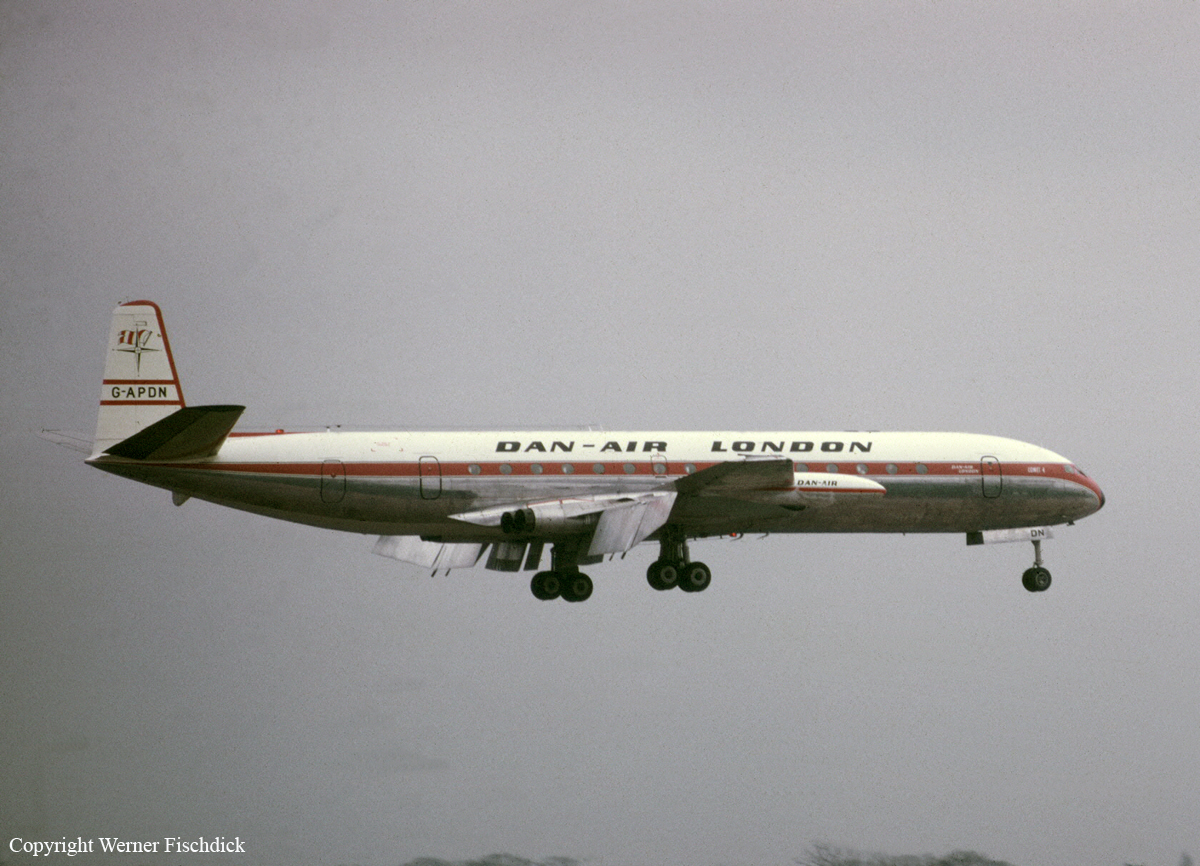
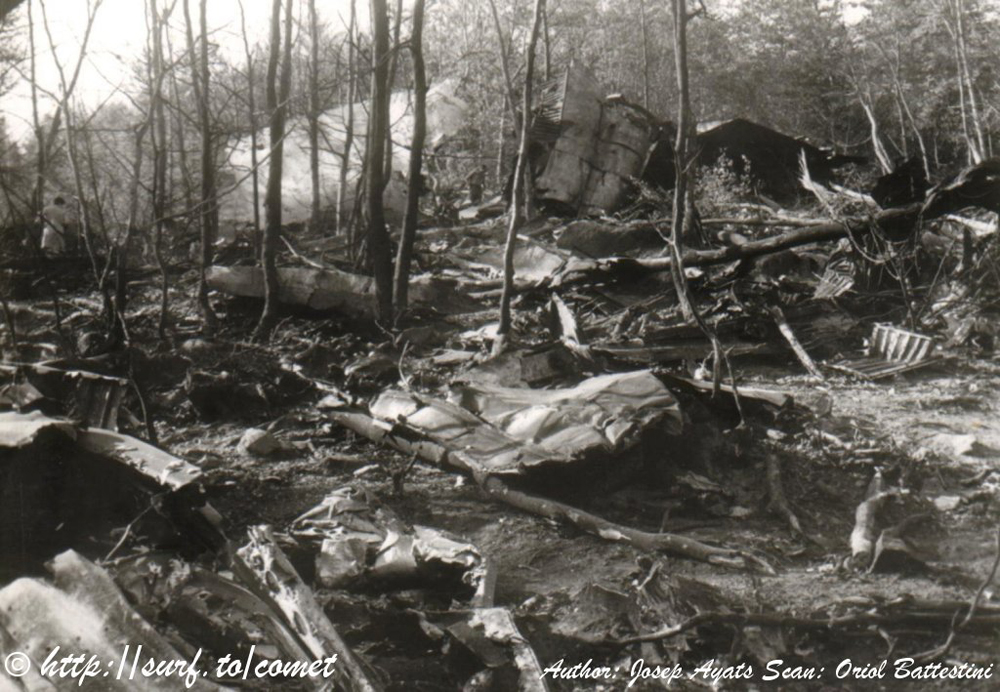
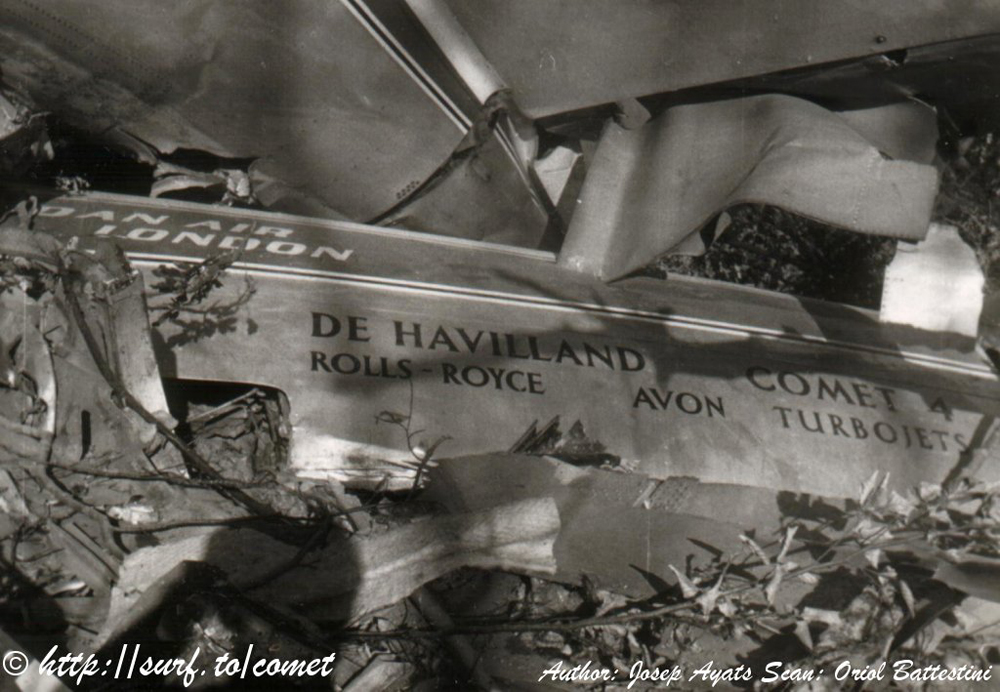

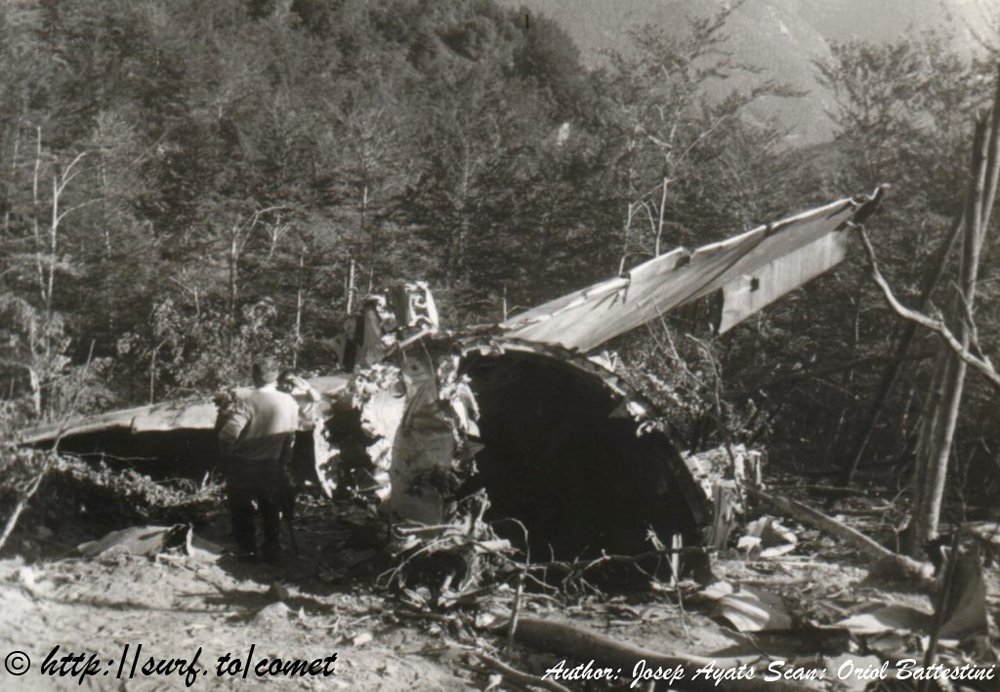
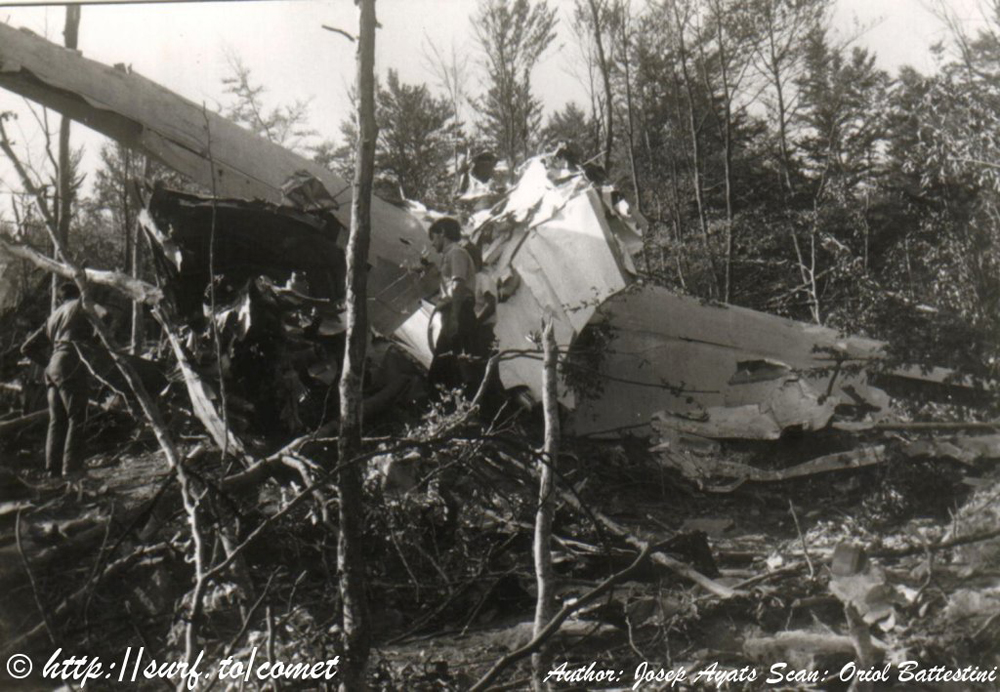
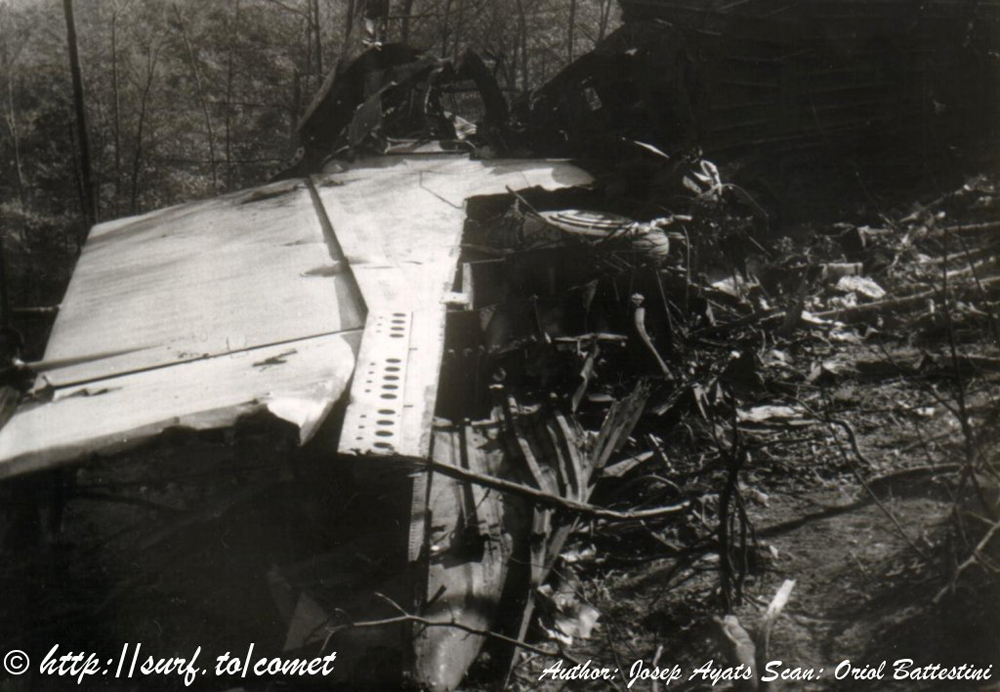

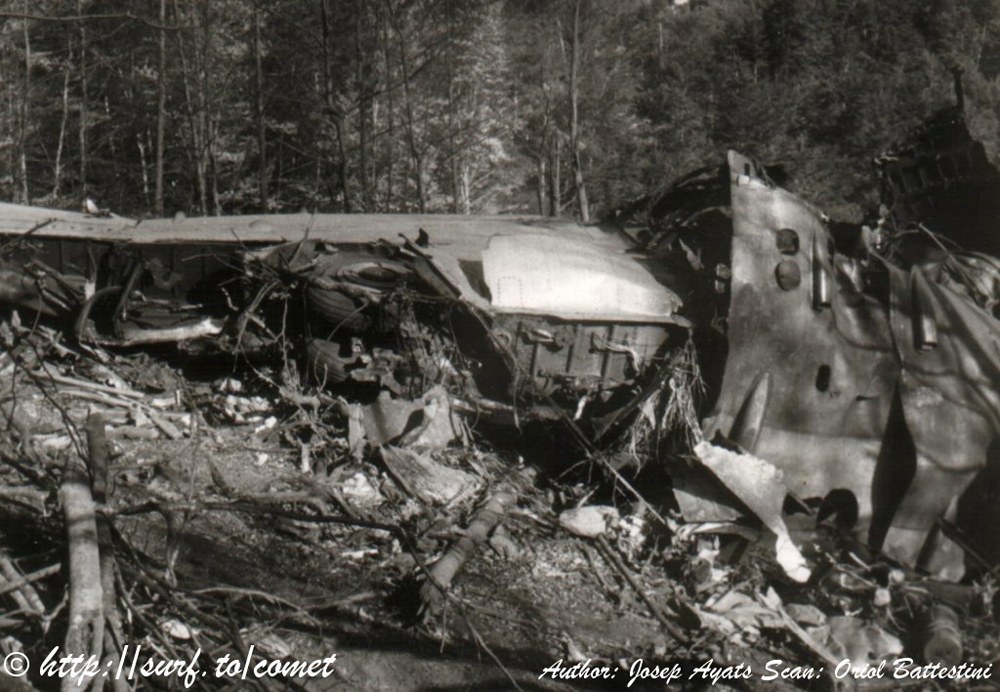

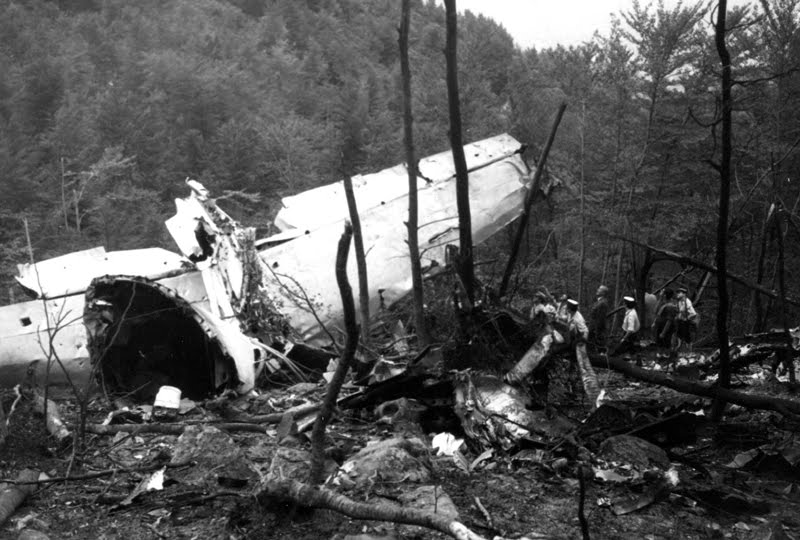


Crash of a Douglas C-54A-15-DC Skymaster in Frankfurt: 2 killed
Date & Time:
Jan 21, 1967 at 0513 LT
Registration:
G-ASOG
Survivors:
No
Schedule:
Manchester – Frankfurt
MSN:
10359
YOM:
1944
Flight number:
BE200
Crew on board:
2
Crew fatalities:
Pax on board:
0
Pax fatalities:
Other fatalities:
Total fatalities:
2
Captain / Total hours on type:
1000.00
Aircraft flight hours:
35500
Circumstances:
Flight BE/LH200 was a non-scheduled international cargo flight from Manchester to Frankfurt. An IFR flight plan via Congleton beacon, airways Amber 1, Amber 2, Blue 3, Dover beacon and airway Green 1 to Frankfurt was filed. Take-off from Manchester was scheduled at 0010 hours GMT; however, because of a malfunction in the door warning device, the flight took off at 0119 hours. At 0402 hours it contacted Frankfurt Approach Control. It was requested to report over Frankfurt VOR and was given a QNH of 1018 mb. At 0405 hours the flight reported over Frankfurt VOR at FL 60 and was instructed to carry out an ILS approach to runway 25R. At approximately 0410 hours the flight was advised that it was 8 miles from touchdown and instructed to contact the tower on 118.7 MHz and to continue its ILS approach to runway 25R. The flight immediately contacted the tower and was cleared to land on runway 25R, the wind being calm. This was acknowledged by the flight: at no time was the QFE given to or requested by the flight. Two minutes after its last radio transmission and whilst on a heading of about 260°, the aircraft struck a tree approximately 2 700 m before the threshold of runway 25R and 100 m left of the extended centre line. After striking several more trees it continued on a track of about 280' and crashed. The accident occurred at approximately 0413 hours. The aircraft was destroyed by impact forces and a post crash fire and both crew members were killed.
Probable cause:
The accident is probably attributable to the fact that the crew did not set the altimeters in the final approach according to the instructions in the operations manual. This error was aggravated by the fact that the final approach checklist did not coincide with the altimeter setting procedure. In consequence the crew unintentionally flew below critical height and the aircraft collided with trees when the altimeters were showing approximately 200 ft above the critical height. The following findings were reported:
- The flight progressed normally until the last communication of the aircraft approximately 5-6 NM before the threshold of runway 25R. The aircraft then descended below the glide path and collided with trees approximately 2 700 m before the threshold,
- Weather conditions at the airport were above the prescribed weather minima,
- The radio navigational aids, and the approach and runway lighting were operating normally: the strength of the lighting used was adequate for the visibility conditions. The VASIS was inoperative and the crew had been duly notified by NOTAM,
- The approach sequenced flashing lights were not in use,
- No evidence of a malfunction or failure of the aircraft, its engines, or its systems prior to impact was found. The pilot-in-command's altimeters were found one at a setting of 1018.5 mb corresponding to the QNH, the other at 29.92 in. Hg, and the co-pilot's altimeter at a setting of 30.08 in. Hg corresponding also to the QNH. In accordance with the operator's instructions and with normal crew practice, both the pilot-in-command's first altimeter and the co-pilot's altimeter should have been set at the QFE.
- The flight progressed normally until the last communication of the aircraft approximately 5-6 NM before the threshold of runway 25R. The aircraft then descended below the glide path and collided with trees approximately 2 700 m before the threshold,
- Weather conditions at the airport were above the prescribed weather minima,
- The radio navigational aids, and the approach and runway lighting were operating normally: the strength of the lighting used was adequate for the visibility conditions. The VASIS was inoperative and the crew had been duly notified by NOTAM,
- The approach sequenced flashing lights were not in use,
- No evidence of a malfunction or failure of the aircraft, its engines, or its systems prior to impact was found. The pilot-in-command's altimeters were found one at a setting of 1018.5 mb corresponding to the QNH, the other at 29.92 in. Hg, and the co-pilot's altimeter at a setting of 30.08 in. Hg corresponding also to the QNH. In accordance with the operator's instructions and with normal crew practice, both the pilot-in-command's first altimeter and the co-pilot's altimeter should have been set at the QFE.
Final Report:
Crash of a Vickers 635 Viking 1B in Agadir
Date & Time:
Dec 22, 1959
Registration:
G-AMGG
Survivors:
Yes
Schedule:
Manchester – Agadir
MSN:
290
YOM:
1947
Crew on board:
4
Crew fatalities:
Pax on board:
32
Pax fatalities:
Other fatalities:
Total fatalities:
0
Circumstances:
Upon landing at Agadir Airport, the tire on the right main gear burst. The airplane swung for about 100 meters when the right main gear collapsed. The airplane came to rest on runway and was later considered as damaged beyond repair. None of the 36 occupants was injured.
Probable cause:
Tire burst and undercarriage collapsed on landing.

Crash of a Vickers 701 Viscount in Manchester: 22 killed
Date & Time:
Mar 14, 1957 at 1346 LT
Registration:
G-ALWE
Survivors:
No
Schedule:
Amsterdam – Manchester
MSN:
4
YOM:
1952
Flight number:
BE411
Crew on board:
5
Crew fatalities:
Pax on board:
15
Pax fatalities:
Other fatalities:
Total fatalities:
22
Captain / Total hours on type:
1051.00
Copilot / Total hours on type:
132
Aircraft flight hours:
6902
Aircraft flight cycles:
4553
Circumstances:
The aircraft was reaching the end of a scheduled passenger flight from Schiphol, Amsterdam, with a crew of 5 and 15 passengers aboard. Until the aircraft was roughly a mile from the threshold of the runway it was apparently making a perfectly normal approach, then it made a banked turn to starboard and continued to descend until the starboard wing tip struck the ground. With the starboard wing furrowing the earth and breaking up, the aircraft, obviously completely out of control, went on until it struck some houses, demolishing two of them (in one of which a woman and her infant son were killed). The aircraft came to rest in the ruins of the houses and immediately caught fire and set fire to the houses. All the crew members and passengers were killed in the accident. The position of the final crash was about 900 yards short of the runway and 200 yards to the right of its extended centre line.
Probable cause:
The cause of the accident was the fracture, due to fatigue, of the 9/16 inch bolt holding the bottom of the No. 2 starboard flap unit.
Final Report:


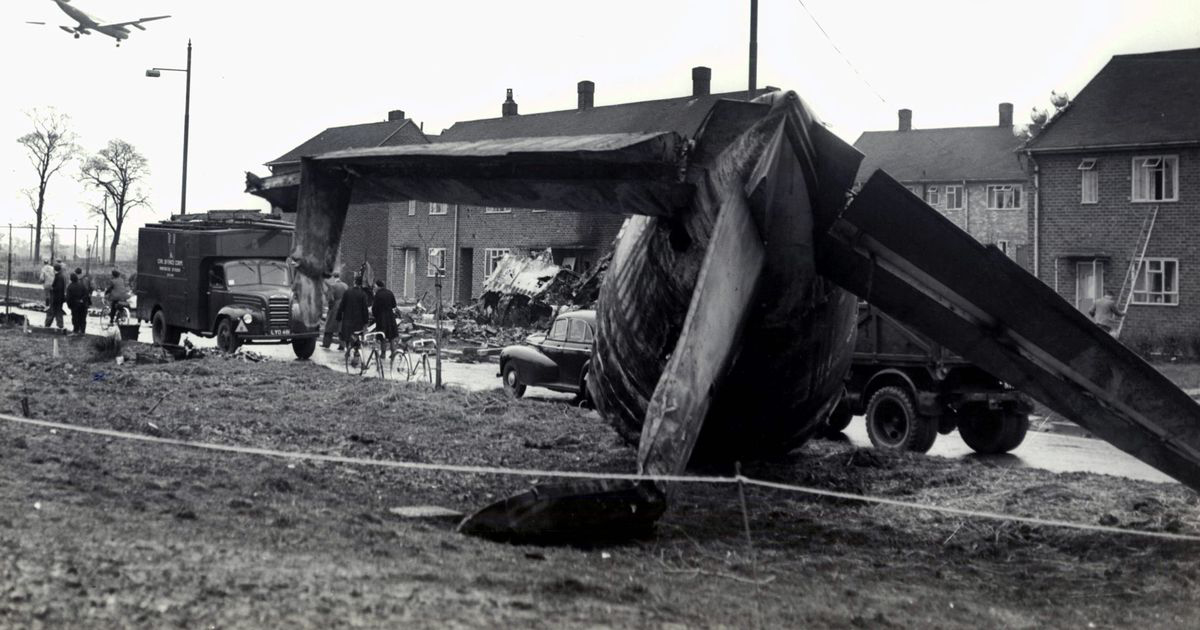
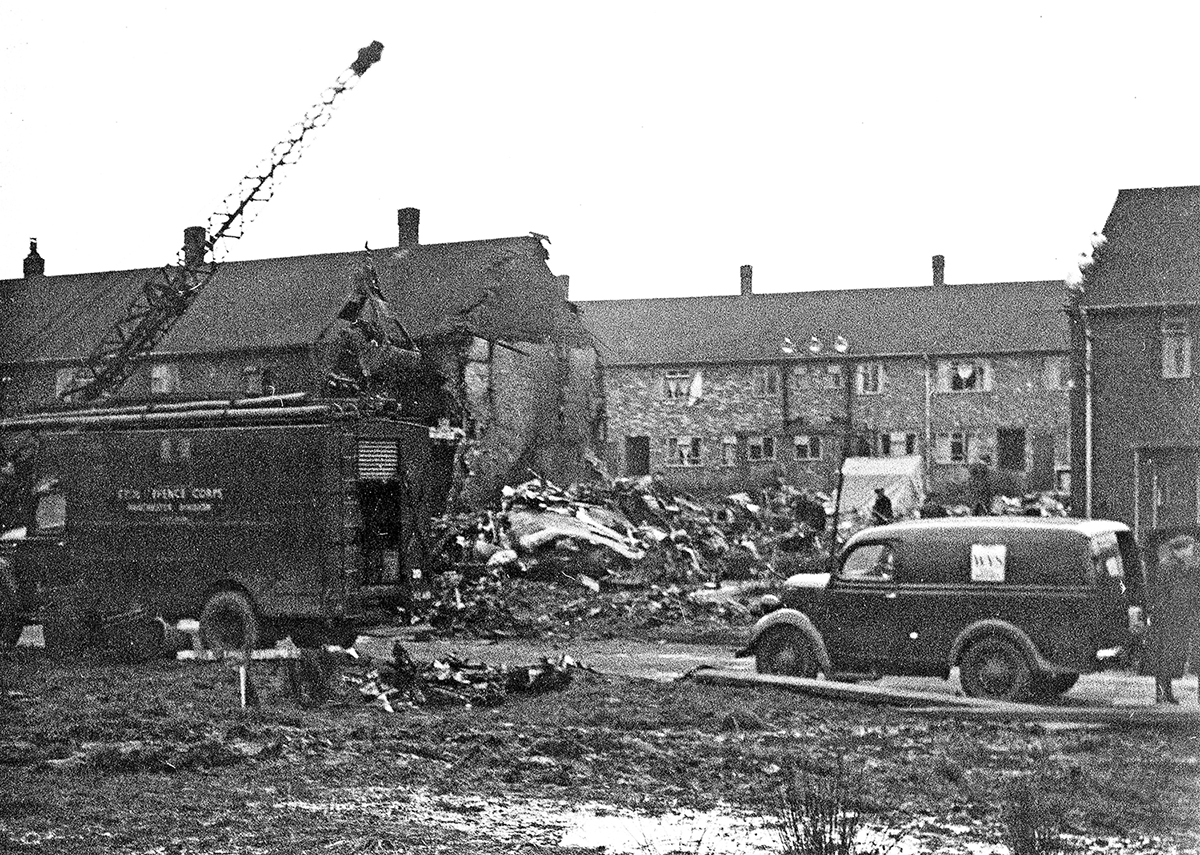
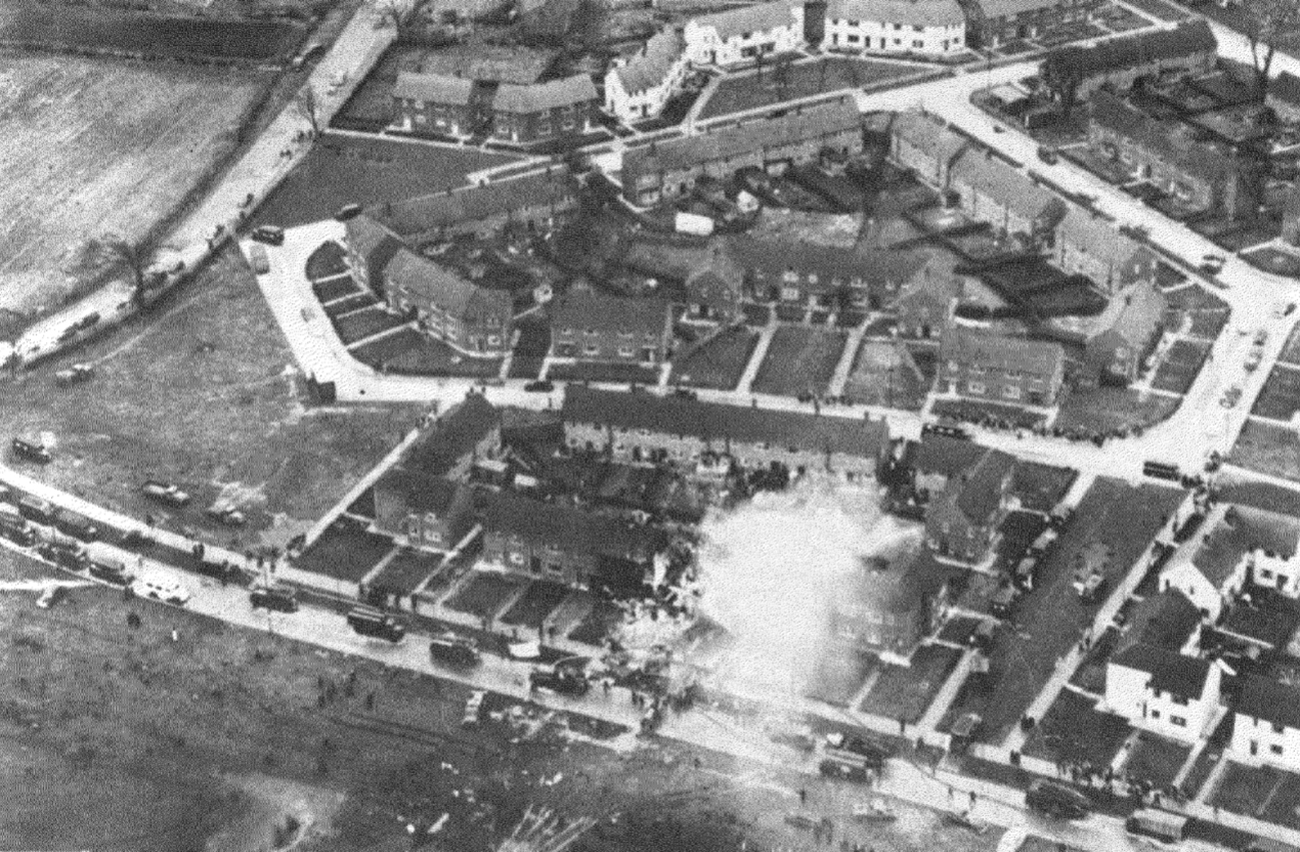
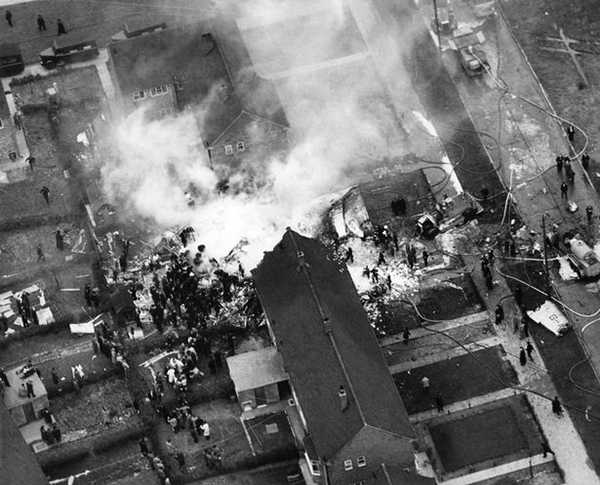
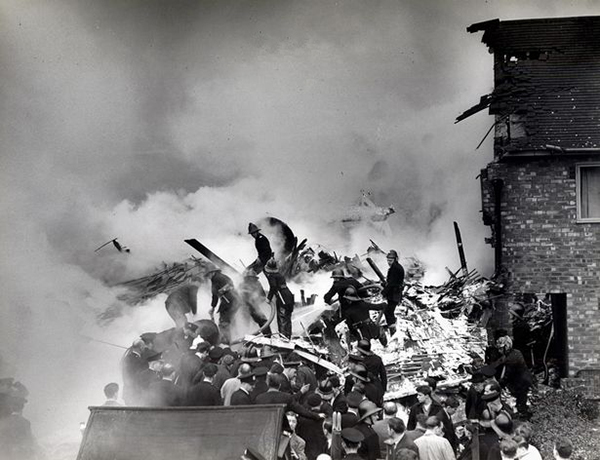
Crash of a Douglas C-47B-16-DK in Grenier Field AFB
Date & Time:
Apr 24, 1956
Registration:
43-49408
Survivors:
Yes
MSN:
15224/26669
YOM:
0
Crew on board:
0
Crew fatalities:
Pax on board:
0
Pax fatalities:
Other fatalities:
Total fatalities:
0
Circumstances:
During a late-spring snowstorm, the aircraft crashed into a swamp located at the north end of Perimeter Road at Grenier Field AFB, Manchester, after striking the corner of the fire station hangar. The aircraft broke in two while the right wing was sheared off. All occupants, local dignitaries, were injured.








